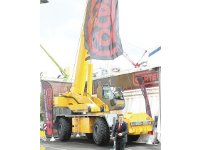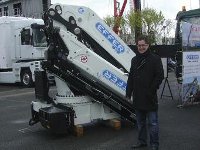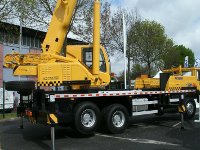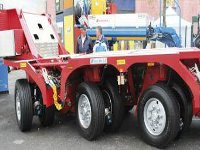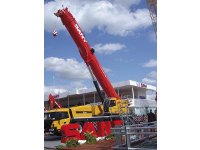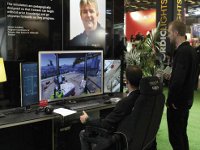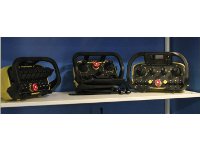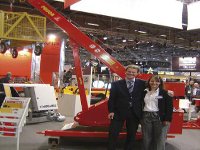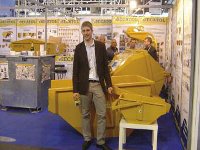A Parisian hors d’oeuvre
18 May 2012Intermat may not have satiated those hungry for the biggest of crane launches, but it offered a tasty selection of innovations and new developments, and whet appetites for Bauma next year.
The Paris show offered the big manufacturers a chance to share their latest news and discuss the market. For Terex, cranes division president Kevin Bradley said that the company was seeing sales return, with early signs of growth at ConExpo accelerating this year. "We feel a lot of the indicators we look at, like fleet utilisation and expectation of fleet utilisation, show a multi-year positive cycle, extending over three or four years," said Bradley.
"Europe is fairly flat, but there's a lot of growth from developing markets and North America is particularly strong." As well as being helped by the general recovery of the market, Bradley says Terex's growth was propelled further by the 'exceptional' range of products launched at the US show last year.
Over recent years, Bradley says, the focus of the company's development has been "not necessarily on bigger capacity or longer reach, but on innovation that helps our customers be more effective." The company is working to bring together its legacy brands with a common look and feel, and an ergonomic experience that is the same across its range.
Liebherr was very firmly focussed on big cranes, launching its largest flat-top, the 16t 380 EC-B 16 Litronic, with a maximum jib length of 75m. Despite being the biggest crane of its type in the company's range, the 380 EC-B is designed to be fully containerised. The counterjib uses an easy-to-assemble two-part design and its machinery deck uses just four components, with only one bolt needed for each connection.
Liebherr Biberach marketing director Hans-Martin Frech says the crane has been designed to be used with a choice of standard freestanding HC tower sections, or the company's internal climbing IC tower sections, both so it can be climbed internally, and so that it can be shipped more easily.
Another key design feature, Frech says, has been safe erection. When fitting the slewing platform, the fitter works from within the platform, surrounded by an adjustable handrail, instead of on top of the platform. The crane makes use of Liebherr's Litronic control system and LiDAT fleet managemeant system, with Liebherr's frequency converter drives for efficient operation and precise control.
Zoomlion
On the first day of Intermat, Chinese manufacturer Zoomlion launched the first of a new series of flat-top tower cranes based on designs by Franc Jost, one of the pioneers of this crane type.
At a press conference to discuss the launch, Zoomlion construction crane division general manager Helen Huang explained that the new series of cranes would be "made in China using German designs, in accordance with EU standards." The new cranes spring from an agreement signed last summer, under which Zoomlion bought all of Jost's flat-top crane technology.
Harry Yu, deputy general manager for Zoomlion, described how the new T-series cranes would develop on Jost's JT-series cranes. The first crane to be launched, the T320-16, adds 4t to the maximum capacity of its JT series counterpart.
Jost explained that the new cranes, with their quick connection points, would be easy to assemble. A 24m-high crane, with standard jib, could be erected in around 10 hours, including safety inspections.
The first of the cranes has been sold to Soon Douglas, a subsidiary of Singapore's Tiong Woon. A Tiong Woon spokesman said: "Singapore has very strict regulations on machinery. In order to bring the crane to Singapore, we have to go through a lot of testing and gain the approval of the Ministry of Manpower.
"We are proud to bring the T320-16 to Singapore. We expect to get approval by the end of June. Our intention is [to buy a] minimum of 20 units followed by another 10 maybe by the end of the year.
At Intermat, Zoomlion will be looking to sell the cranes to European buyers. The company's product manager for Europe, Stefano Vittadini, said: "16t cranes are popular in Europe, but not for all markets. It's particularly good for Germany and Poland. Our aim is to sell 10 units by the end of the year, and double that next year."
Atlas
At Bauma 2010, two years ago, Fil Filipov, former president and CEO of Terex Cranes, announced he would be buying the Atlas knuckleboom and excavator company from his old employer. At this year's big show, Cranes Today spoke with him about his progress since then.
It hasn't been easy to get the newly independent company working as he wants. Filipov says: "As the French say, you can't make an omelette without breaking eggs. The company was losing a lot of money, more than €2m a month, and I had to make some changes. After about six months, I stepped in and told the unions and works councils, who had been running the place for many, many, years before, 'This is my company, and I, and management, will run the company'. So, we locked heads and we had a seven week strike.
"I cannot say that things are rosy yet, but at the end of the day, we are very successful in what we do. We eliminated our losses in 2011, we don't have any bank debt, so we do very well, both in the European mainland, and in the UK.
"We did not close anything, we restructured down the people, and we subcontracted some work. Our sales have increased, our market share has increased in Germany. Our business is related to about 50% German customers, and 35% additional in the Eurozone, so we're really not related to any exchange rates. We have a very, very, good dealer network for cranes and excavators. Our main drive has been customer and special adaptation satisfaction. We have introduced and improved many of our products."
Many of these new products were on show at Intermat, including six new cranes. Atlas says the new cranes offer improved performance at a lower net weight. All jibs on the new cranes can work at a negative offset, allowing them to reach under obstacles. A new boom design provides protection for all hydraulic systems, while still allowing easy access.
The company's new E-series cranes offer remote control as standard. It has also developed a new system to provide real-time feedback on crane stability, whatever the set-up, in line with new EU regulations.
Filipov says new development will continue to focus on specialisation, citing growth in Italy as an example of why this works. "I basically went to the niche market that Atlas is known for: the attachments, the special machines, the introduction of different things that customers want," he said. "We started completely new down in Italy, selling more than 30 machines last year. We selected a few dealers that were with competition before, and we made products for the Italian market. We want to be driven by what the regional requirements are, not by what the mass volume is requiring. Italy is still a very hard market for loader cranes, I am even surprised by the success we have had: I am attributing it strictly to serving the customer and what the people want."
NLMK
Russian steel group NLMK used Intermat to unveil plans for a new line of steel plate suitable for cranes at its plant in Clabecq, Belgium.
The plant, one of many bought by the acquisitive Russians over recent years, has rolled carbon steel plate for hundreds of years. In 2010, NLMK invested €100m in a new quenching and tempering line at the site, to treat steel slabs from Russia. The company is now able to offer two new ranges, of abrasion resistant, and high yield strength, steels. While the former is aimed at products like mining buckets, the latter will be suitable for crane booms.
The first product, Quend 700, at 690MPa, is suitable for smaller cranes. The company will launch a second line, Quend 960, suitable for bigger crane booms, this year.
NLMK has invested in a new continuous casting line, vacuum degassing facility and metallurgical testing equipment, in order to provide the clean steel needed for these products. The company says its steel slab now achieves hydrogen levels below 2ppm, making it competitive for crane builders.
XCMG
XCMG displayed its new E-series of cranes designed for European customers. On show at Intermat were the 30t XCT30E truck crane, shown here, and the 70t RT70E rough terrain. The new Europe-focussed line covers three truck cranes, also including the 50t XCT50E and 70t XCT70E. The rough terrain cranes are also offered in a 120t model, the RT120E. The cranes are sold in the EU through Michielsens.
Locatelli
Italian manufacturer Locatelli was showcasing what is currently its biggest rough terrain crane available, the 65t GRIL 8700T, on its stand in Paris.
The two-axle machine has a 35.4m to 52.9m boom despite its compact 12m x 3m x 3.7m RT dimensions, and is being sold both domestically and overseas. Even with 50% of current sales of the 65- tonner having been exports to customers in Northern and Central Africa, South America, the Far East and Europe, the firm says its domestic sales have fared well since its release.
But with its acquisition last year by Remazel, Locatelli is now pushing towards bigger public works jobs and the oil and gas industry in developing markets.
Speaking to Cranes Today, sales manager Michele Mortarino explained: "We've been bought by Remazel, they are an Italian company active in the oil and gas field mainly in the production of winches to be mounted on platforms to put their pipelines on the sea bed. It's a very specific kind of business, but this company has had strong growth in the last 30 years and now as a group we have a turnover of around €500bn. They invested all their effort into technical development and they are doing the same with Locatelli."
Mortarino says that despite the length of the integration period after the transition temporarily detracting from the company's performance, the new situation Locatelli finds itself in is an exciting one with many opportunities.
Access to the oil and gas industry through its parent company's client base is already bearing strange fruit for the company, in a departure from its traditional roots.
"For both companies they are developing products with lifting booms," says Mortarino. "We have the technology for lifting booms, they are dealing with the main oil and gas companies worldwide, and we can take advantage of this. This application is for vessels and platforms, this is not for the rough terrains or cranes as a cross-section. This could be the direction at least."
So with a potential new market for Locatelli booms on vessels, the focus has shifted slightly for the firm. That is not to say Locatelli is moving away from other earlier planned developments, such as its line of city cranes, but simply widening its gaze. Mortarino adds: "We have the city crane, 20t, it is also quite successful. We sold various units in Southern America. It was our first export outside of the European community. The demand is growing up a little even if we know it is a niche, but the development of the city crane range is scheduled in the near future so we will invest some effort also in this direction."
Mortarino also says that a prototype for a 40t city crane is now ready, in good time too for what he perceives as a strengthening market for city cranes, but for now the focus for Locatelli is strongest on its RT range with the release of a 75t RT imminent.
Sany
At the forefront of its 4,680m2 stand at Intermat, Chinese manufacturer Sany was introducing its first European-developed all terrain, the SAC 2200F, with a 220t lifting capacity. The crane was produced last August.
The crane was developed by 21 engineers in Germany and in China in accordance with European Standards. Sany said its engineers spent three months conducting on-site market research to find out exactly what kind of crane was required by European customers.
The main components are sourced in Germany, and the crane is TÜV certified. Emissions requirements under the European standard IIIB are also met by the all terrain's engine.
The maximum main boom length of the SAC 2200F is 60m. The boom length with the added jib is 103m. The transportation weight of the crane on five axles is less than 60t. "This crane is a completely localised product," said Sany R&D engineer Ren Liyou. "We make full consideration of customer preference in designing it, adding display of winch speed and direction into the operation interface. Meanwhile, the crane with fiveaxle chassis and single axle core lighter than 12t, complies with the Euro IIIB emission standard and has passed strict road transport permission certification."
Sany explained the choice to design cranes in Germany is part of its plan to globalise its crane markets.
"Both the localised products and localised sales at Intermat come from the successful experience of Sany's globalisation process for the last ten years, and they have proven again that localisation is the right choice for Sany to go global."
Effer
Italian Knuckleboom crane manufacturer Effer was launching three new cranes from its Large Range: Models 525, 395, 685.
Effer's knuckleboom cranes are used in many applications, including for installation work in buildings up to 10 stories tall, as the design allows the driver to get very close to buildings.
One of its newest knucklebooms, the Model 395 (26t), was displayed on a stand hosted by its French distributors and service providers Appydro.
The new Model 395 knuckleboom on display was in the prototyping phase, and will be ready to buy internationally in two months.
Loïc Muntz of Melun Hydraulic Appydro's mother company, said: "I think that Effer has made a market study and asthey have the 42tm and 53tm, they wanted to add this to the range with a 46tm crane."
The other new knuckleboom, Model 685 was launched at METS in Amsterdam in 2011.
Also on the stand was Effer's Model 955 (26-32t) knuckleboom with a jib CS with 42m of vertical extension for installations in tall buildings, especially for installation of air conditioners.
Effer says that its knucklebooms come with different options for its boom sections. Each boom comes with different jib options that can be chosen to meet the application, and jibs can be used with a hoist for mobile-crane lifting applications.
As a signature offering, the different knucklebooms may be provided with outriggers which are arranged in an 'X' formation for improved use of space.
Effer says its presence with the new cranes at Intermat generated a lot of interest from its target markets, particularly for its larger cranes. "We have made lots of contacts with the biggest models. When they come they say 'I want the largest one you have,'" says Muntz.
Jaso
Jaso's newest development for Intermat 2012 was easy to spot on the skyline, from the firm's H series of topline cranes, the J360 tower crane.
With four falls of rope, the J360 can handle a 4t load at its maximum reach of 60m, or 18t at 15m. Its maximum under hook height, without tying off, is 166.5m, and the model sports a fairly compact counter-jib that can be set up for a length of 12.9m or 15.3m at maximum jib length.
Having only confirmed the crane to demonstrate the week before the show, Jaso's export manager, Dick Huitema, said the company barely had time to paint it before bringing it to the show.
Commenting on its design Huitema said: "The J360 is a crane which we have developed for specific markets in which the maximum jib length is not over 60m, we're thinking basically of Asia. One of our main areas is Singapore, but we also have France in mind where the standard is 60m.
"The J360 is a continuation of what we have been starting with the J600 cranes. The lower part of the hook block to the top end of the crane that is similar to equivalent topless cranes, not all of them, but all of the topless cranes that we have seen on sites."
Although not at the show, some other Jaso products have recently been introduced, including the J208 luffing lib tower crane, built using the existing J180 as its template.
Huitema explained that to compete with other manufacturers in a similar class to the J180, which has a maximum lifting capacity of 12t, it has developed the J208 with a 16t maximum lifting capacity.
This model improves on the J180's maximum reach to reach 55m, and lifts 2.2t at the jib end with two falls of rope.
Scheuerle
Exhibiting a new version of the Superflex trailer, the Superflex ST, Scheuerle and Nicolas used Intermat 2012 to introduce visitors to some of its more unique features.
Released early in the new year, the Superflex ST is available either as a five to eight axle version from Scheuerle or a three to eight axle version from French sister company Nicolas.
Its key design feature is the addition of two shiftable axle lines that allow transport firms to hydraulically extend the platform to optimise the trailer's setup for the centre of gravity of the load being transported.
Used properly, Scheuerle says this can help to protect the gooseneck against overloading, and a stronger main beam than its preceding Superflex trailers means that it can accommodate a wide range of configurations as may be needed for difficult jobs.
After extension the axles can be bolted, at 500mm intervals along the telescoping section, with numerous lashing rings allowing a 13.4t lash capacity, along with room for inserted extension beams for use as stakes that can be slid into the platform when not in use. Easy alignment of the shiftable axles then enables the Superflex ST to achieve steering angles of up to 60°.
Capable of handling 14t per axle, with a high axle compensation of 650mm and a platform height of just 1m from the ground, the Superflex ST has been designed with European road regulations in mind.
Secatol
Although no new products have been released over the last two months, there have been developments in the offing for Autec.
In fact the French office of Autec itself is only a two-month-old development for the company, part of a new focus on widening its customer base.
With the current boom in prospects in the main emerging market countries, Autec has decided to hit the BRICs, opening a site in China, with another planned for Brazil later this year.
Last year, Autec introduced the Dynamic series of remotes for use with mobile hydraulic machines such as crawler cranes, crushers, loader cranes and telehandlers. The series is aptly named as all the models have dynamic access to any free frequency in the frequency band.
The series comes in three different models (FJS, FJL and FJM) and with the option of two receivers, one with an analog interface and one with a CAN/CANopen interface. Any of the new remotes can be modified to meet client requirements. The range includes a removable S-Key providing user identification and programming data.
These receivers are designed for safety and accordingly adhere to the requirements of EN ISO 13849-1, including Stop and UMWD functions.
Radio and feedback systems allow operators to access the frequency band, and two-way communication with high integrity messages is possible using Autec's recently developed Flex Safe Architecture. Optional features include single or dual-axis joysticks. End users looking for a more standard configuration options can select switches, potentiometers and pushbuttons. Customers with different power use concerns can select models with voltage-and current-driven outputs and actuators. The models can be configured to handle 12 analog and 64 digital sequences.
Huchez
International manufacturer Huchez exhibited at Intermat, showcasing the 500kg lifting capacity Puisor M at the stand of Chastagner, a French rental firm and sister company.
The Puisor range of three cranes for underground sewer maintenance is available with lifting capacities from 250kg to 2t. Puisor cranes are intended for set up above ground so they can lower or lift loads through a manhole or access point.
Maintenance crews use the cranes to lower equipment and tools underground and remove debris while working underground. A man-riding version, allowing one person to drive underground, is under development, the company said.
The newest crane in the Puisor series, launched in 2010, is the Puisor S. As the lightest lifting and lowering crane in the Puisor series, it can rotate 360° on its small outriggers and lift a maximum load of
250kg.
While Puisor S has a height under hook of 3.2m, it can lower down to a maximum of 51m. Huchez markets Puisor cranes to private maintenance companies that clean and maintain underground sewage networks.
In France, SAD (Service Assainissement Dépannage), a private maintenance company, uses the range for lowering tools and equipment. Antoine Huchez, president of Huchez, explains the Puisor series meets the demand for sewer maintenance cranes in France by filling a gap in the market left by a now-defunct company.
"The principle is that the manufacturer that made these cranes disappeared 10 years ago, and there was only manufacturer in the market. Huchez is now the only one."
Companies in France can either rent or buy the Puisor range from Chastagner.
Huchez is looking at selling elsewhere in Europe. "Our interest is to sell the crane in Great Britain, Belgium the Netherlands," says Huchez. "We prefer to sell through our distributors but invite interested potential customers to contact us directly."
Ascorel
French manufacturer Ascorel's team of 20 designers works with German remote control manufacture Hetronic, designing the control systems for a number of its products, as well as producing its own brand of weighing systems, load moment and wind speed indicators.
However, at Intermat 2012, Ascorel was much more animated about another of its product lines, its anti-collision systems designed for mobile and tower cranes.
Although the currently released version of its MC 602 anti-collision system can be used with either tower or mobile cranes, the firm plans to release an updated model that allows users to monitor both tower cranes and mobile cranes in simultaneous operation on the same system. Suitable for use with any mobile crane and both luffing and trolley jib tower cranes, the updated MC 602 will automatically update the topography map of the site crane management system. This is automatically done for the position of each mobile crane it is fitted to once the crane has stopped and extended its outriggers prior to lifting operations. This information is then fed back to each mobile and tower crane to determine its safe operating zones, alerting operators of any potential hazards as work progresses. Ascorel expects the MC 602 to be ready by September 2012.
Autec
Although no new products have been released over the last two months, there have been developments in the offing for Autec.
In fact the French office of Autec itself is only a two-month-old development for the company, part of a new focus on widening its customer base.
With the current boom in prospects in the main emerging market countries, Autec has decided to hit the BRICs, opening a site in China, with another planned for Brazil later this year.
Last year, Autec introduced the Dynamic series of remotes for use with mobile hydraulic machines such as crawler cranes, crushers, loader cranes and telehandlers. The series is aptly named as all the models have dynamic access to any free frequency in the frequency band. The series comes in three different models (FJS, FJL and FJM) and with the option of two receivers, one with an analog interface and one with a CAN/CANopen interface. Any of the new remotes can be modified to meet client requirements. The range includes a removable S-Key providing user identification and programming data.
These receivers are designed for safety and accordingly adhere to the requirements of EN ISO 13849-1, including Stop and UMWD functions.
Radio and feedback systems allow operators to access the frequency band, and two-way communication with high integrity messages is possible using Autec's recently developed Flex Safe Architecture. Optional features include single or dual-axis joysticks. End users looking for a more standard configuration options can select switches, potentiometers and pushbuttons. Customers with different power use concerns can select models with voltage-and current-driven outputs and actuators. The models can be configured to handle 12 analog and 64 digital sequences.
Tenstar Simulation
Along with their more established suite of simulators for excavators and forklifts, Swedish simulation software developer Tenstar Simulation brought their brand new tower crane simulator to Intermat 2012.
Despite the impressive look of the simulator, with the first version of the software completed just a week before the event the firm says there is still plenty that will be added to the final version as user demand dictates, such as additional scenarios.
Touted as a realistic simulator with self-instructive exercises, the student progresses through a set of exercises designed to develop the user's control over different areas of tower crane operation, such as extension of the crane, performing lifts and precision placement.
Gradually, the user will be able to access new more difficult exercises as their competence with each skill increases, while an instructor can monitor data logged in the system and provide feedback.
Tenstar plans to continually add to its tower crane simulator based on user feedback on their experience, explains lead programmer Jon Bäcklund. "The tower crane [simulator] is brand new, it's our first time showing it.
"The first version was only finished about a week ago, so it's still not finished, and by that I mean we are still developing more exercises for it. It's a little bit dependent on what people want from it really."
For now though, Tenstar's main goal is to achieve a level of quality that guarantees its simulator is compliant with the standards required for operator training courses. Up to 35% of the 120 hours of crane operating time that an operator must have to achieve certification can be accrued in a simulator, and this has always been in mind as the end goal.
Developed using guidance from professional instructors, Tenstar includes a realistic driving seat and controls on the simulator in the hope that the high levels of realism will ensure its suitability for parts of the certification process for tower crane operators.
"This one has good educational aspects to it, so it is mainly targeted at operator schools as well as other kinds of training environments. We want operators to be able to use it as part of their certification process. We had the demand for it, so we had to do it, and hopefully we will have some orders for it after full development for it."
